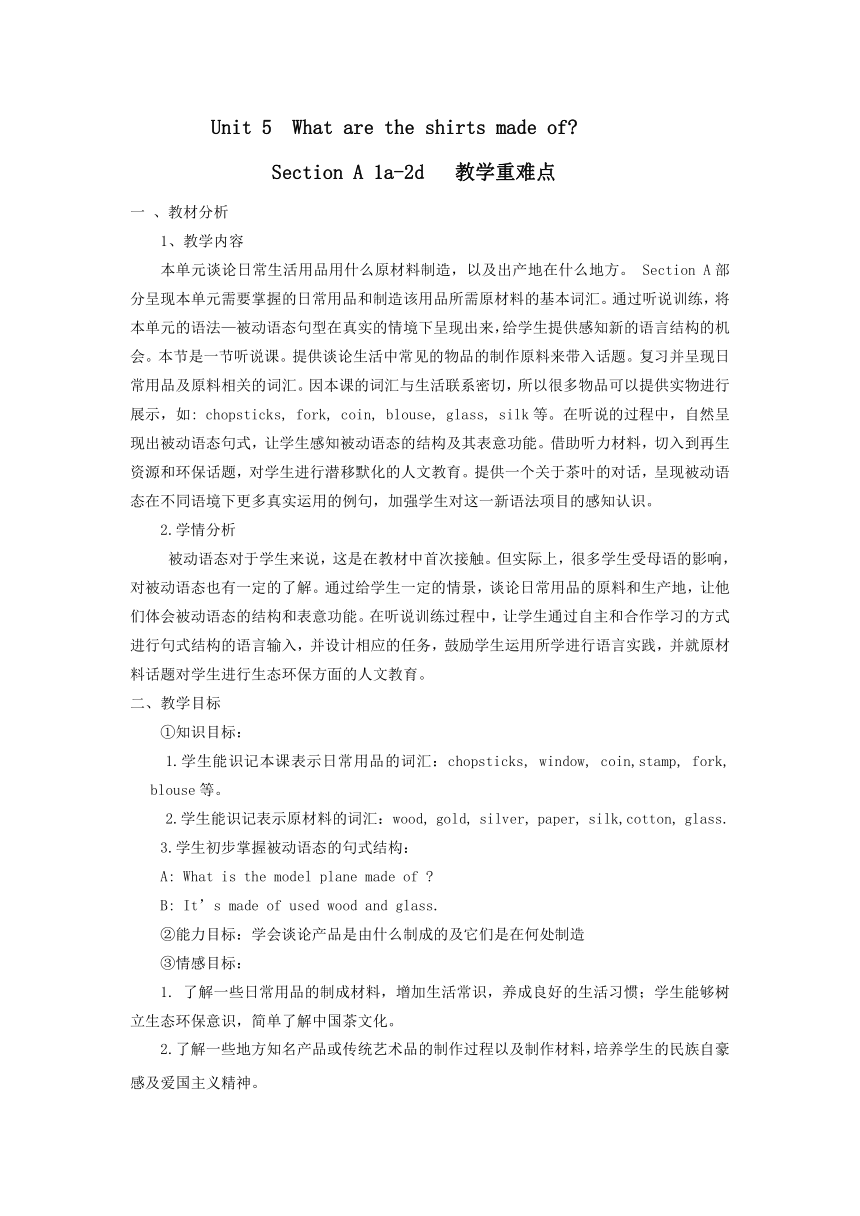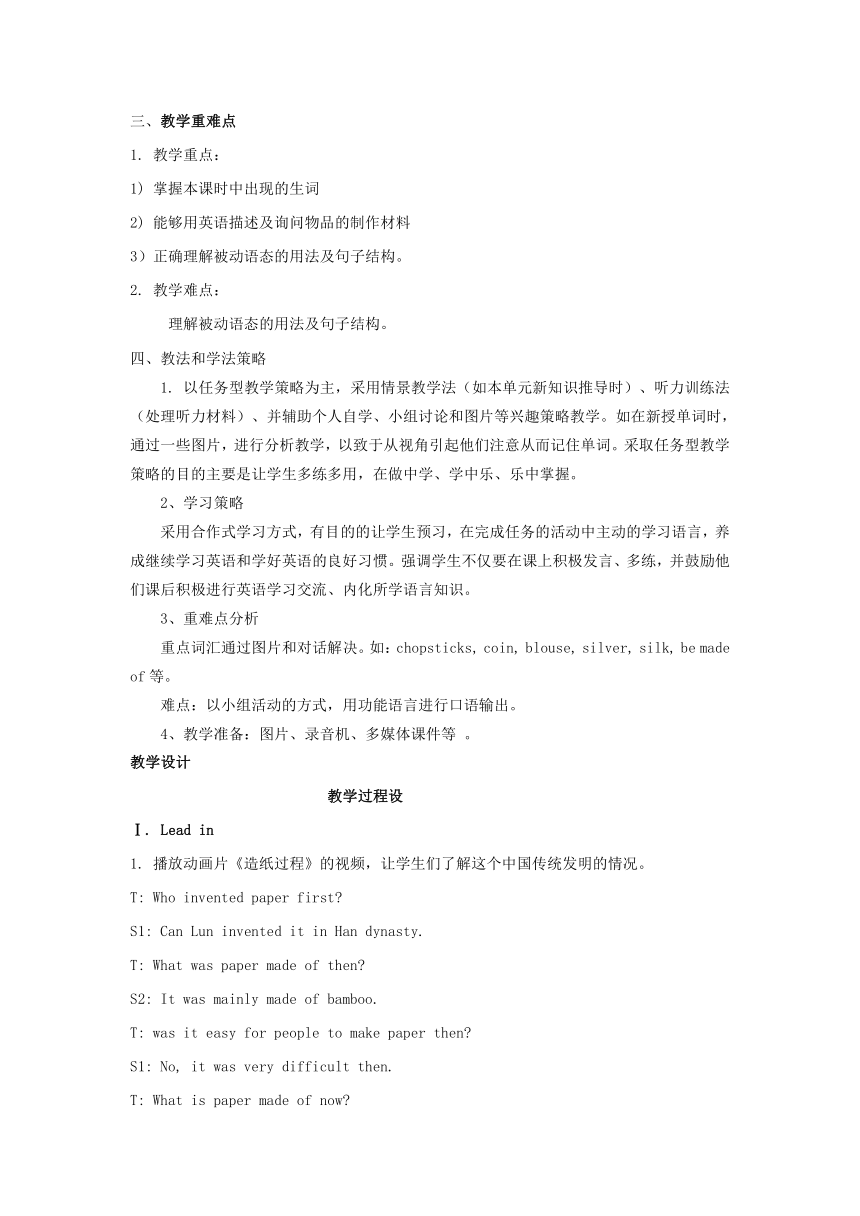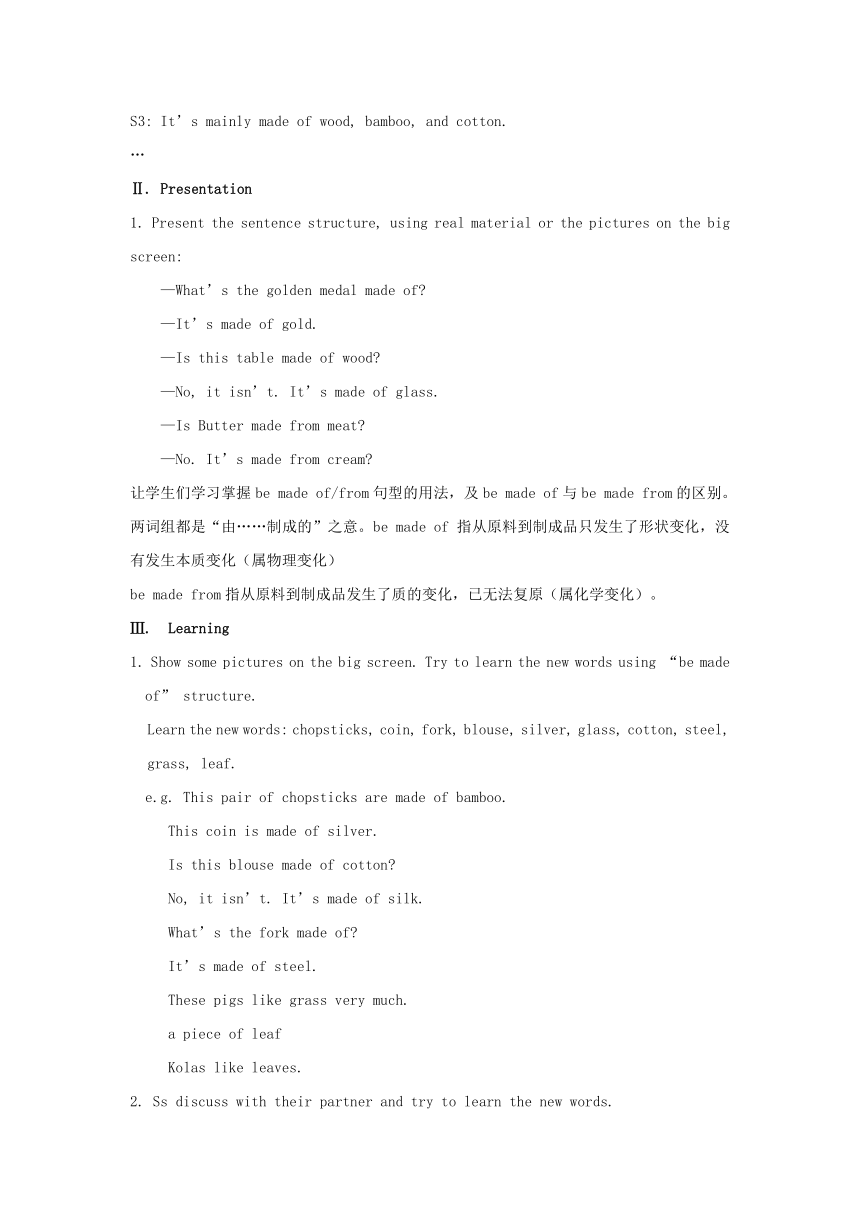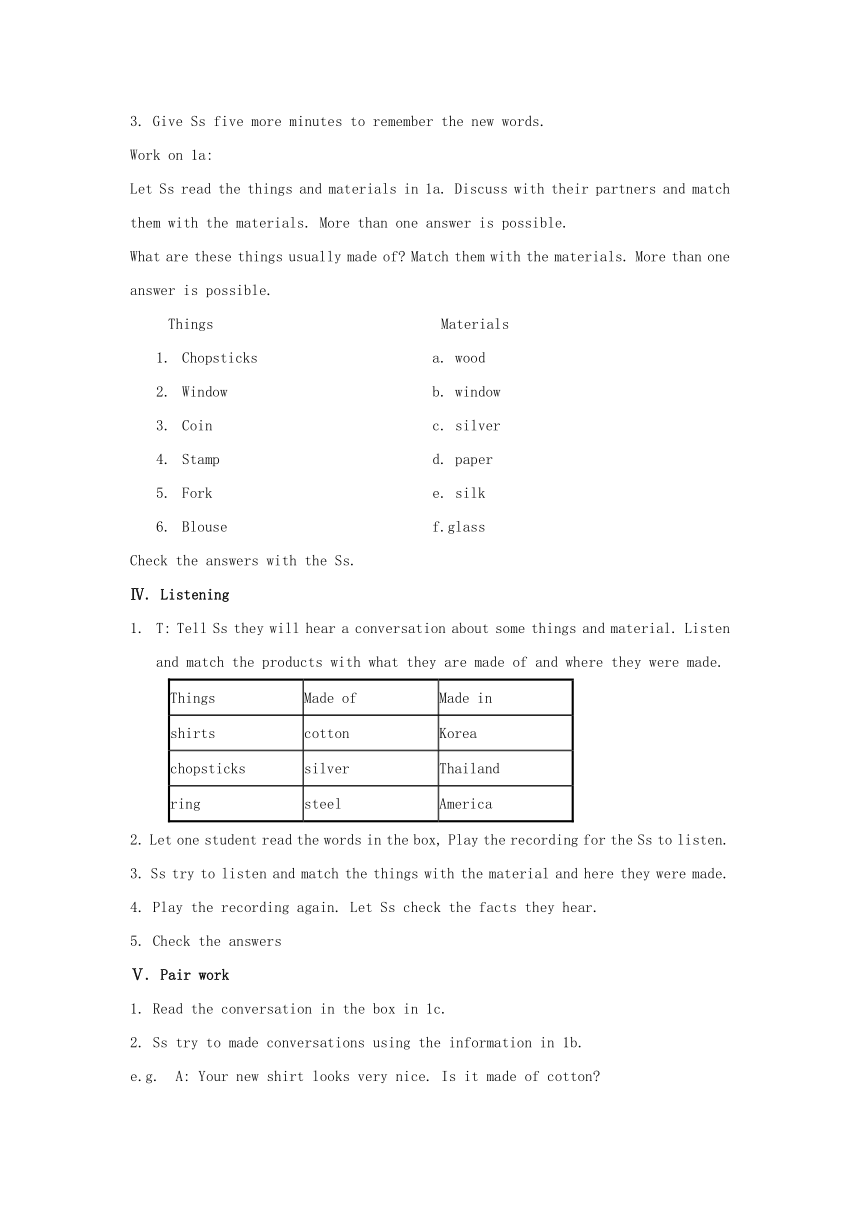人教版九年级全册 Unit 5 What are the shirts made of? Section A 教案
文档属性
| 名称 | 人教版九年级全册 Unit 5 What are the shirts made of? Section A 教案 |  | |
| 格式 | zip | ||
| 文件大小 | 23.9KB | ||
| 资源类型 | 教案 | ||
| 版本资源 | 人教新目标(Go for it)版 | ||
| 科目 | 英语 | ||
| 更新时间 | 2023-01-17 15:20:29 | ||
图片预览




文档简介
Unit 5 What are the shirts made of
Section A 1a-2d 教学重难点
一 、教材分析
1、教学内容
本单元谈论日常生活用品用什么原材料制造,以及出产地在什么地方。 Section A部分呈现本单元需要掌握的日常用品和制造该用品所需原材料的基本词汇。通过听说训练,将本单元的语法—被动语态句型在真实的情境下呈现出来,给学生提供感知新的语言结构的机会。本节是一节听说课。提供谈论生活中常见的物品的制作原料来带入话题。复习并呈现日常用品及原料相关的词汇。因本课的词汇与生活联系密切,所以很多物品可以提供实物进行展示,如: chopsticks, fork, coin, blouse, glass, silk等。在听说的过程中,自然呈现出被动语态句式,让学生感知被动语态的结构及其表意功能。借助听力材料,切入到再生资源和环保话题,对学生进行潜移默化的人文教育。提供一个关于茶叶的对话,呈现被动语态在不同语境下更多真实运用的例句,加强学生对这一新语法项目的感知认识。
2.学情分析
被动语态对于学生来说,这是在教材中首次接触。但实际上,很多学生受母语的影响,对被动语态也有一定的了解。通过给学生一定的情景,谈论日常用品的原料和生产地,让他们体会被动语态的结构和表意功能。在听说训练过程中,让学生通过自主和合作学习的方式进行句式结构的语言输入,并设计相应的任务,鼓励学生运用所学进行语言实践,并就原材料话题对学生进行生态环保方面的人文教育。
二、教学目标
①知识目标:
1.学生能识记本课表示日常用品的词汇:chopsticks, window, coin,stamp, fork, blouse等。
2.学生能识记表示原材料的词汇:wood, gold, silver, paper, silk,cotton, glass.
3.学生初步掌握被动语态的句式结构:
A: What is the model plane made of
B: It’s made of used wood and glass.
②能力目标:学会谈论产品是由什么制成的及它们是在何处制造
③情感目标:
了解一些日常用品的制成材料,增加生活常识,养成良好的生活习惯;学生能够树立生态环保意识,简单了解中国茶文化。
2.了解一些地方知名产品或传统艺术品的制作过程以及制作材料,培养学生的民族自豪感及爱国主义精神。
三、教学重难点
1. 教学重点:
1) 掌握本课时中出现的生词
2) 能够用英语描述及询问物品的制作材料
3)正确理解被动语态的用法及句子结构。
2. 教学难点:
理解被动语态的用法及句子结构。
四、教法和学法策略
1. 以任务型教学策略为主,采用情景教学法(如本单元新知识推导时)、听力训练法(处理听力材料)、并辅助个人自学、小组讨论和图片等兴趣策略教学。如在新授单词时,通过一些图片,进行分析教学,以致于从视角引起他们注意从而记住单词。采取任务型教学策略的目的主要是让学生多练多用,在做中学、学中乐、乐中掌握。
2、学习策略
采用合作式学习方式,有目的的让学生预习,在完成任务的活动中主动的学习语言,养成继续学习英语和学好英语的良好习惯。强调学生不仅要在课上积极发言、多练,并鼓励他们课后积极进行英语学习交流、内化所学语言知识。
3、重难点分析
重点词汇通过图片和对话解决。如:chopsticks, coin, blouse, silver, silk, be made of等。
难点:以小组活动的方式,用功能语言进行口语输出。
4、教学准备:图片、录音机、多媒体课件等 。
教学设计
教学过程设
Ⅰ. Lead in
1. 播放动画片《造纸过程》的视频,让学生们了解这个中国传统发明的情况。
T: Who invented paper first
S1: Can Lun invented it in Han dynasty.
T: What was paper made of then
S2: It was mainly made of bamboo.
T: was it easy for people to make paper then
S1: No, it was very difficult then.
T: What is paper made of now
S3: It’s mainly made of wood, bamboo, and cotton.
…
Ⅱ. Presentation
1. Present the sentence structure, using real material or the pictures on the big screen:
—What’s the golden medal made of
—It’s made of gold.
—Is this table made of wood
—No, it isn’t. It’s made of glass.
—Is Butter made from meat
—No. It’s made from cream
让学生们学习掌握be made of/from句型的用法,及be made of与be made from的区别。
两词组都是“由……制成的”之意。be made of 指从原料到制成品只发生了形状变化,没有发生本质变化(属物理变化)
be made from指从原料到制成品发生了质的变化,已无法复原(属化学变化)。
Ⅲ. Learning
1. Show some pictures on the big screen. Try to learn the new words using “be made of” structure.
Learn the new words: chopsticks, coin, fork, blouse, silver, glass, cotton, steel, grass, leaf.
e.g. This pair of chopsticks are made of bamboo.
This coin is made of silver.
Is this blouse made of cotton
No, it isn’t. It’s made of silk.
What’s the fork made of
It’s made of steel.
These pigs like grass very much.
a piece of leaf
Kolas like leaves.
2. Ss discuss with their partner and try to learn the new words.
3. Give Ss five more minutes to remember the new words.
Work on 1a:
Let Ss read the things and materials in 1a. Discuss with their partners and match them with the materials. More than one answer is possible.
What are these things usually made of Match them with the materials. More than one answer is possible.
Things Materials
Chopsticks a. wood
Window b. window
Coin c. silver
Stamp d. paper
Fork e. silk
Blouse f.glass
Check the answers with the Ss.
Ⅳ. Listening
T: Tell Ss they will hear a conversation about some things and material. Listen and match the products with what they are made of and where they were made.
Things Made of Made in
shirts cotton Korea
chopsticks silver Thailand
ring steel America
2. Let one student read the words in the box, Play the recording for the Ss to listen.
3. Ss try to listen and match the things with the material and here they were made.
4. Play the recording again. Let Ss check the facts they hear.
5. Check the answers
Ⅴ. Pair work
1. Read the conversation in the box in 1c.
2. Ss try to made conversations using the information in 1b.
e.g. A: Your new shirt looks very nice. Is it made of cotton
B: No, it isn’t. It’s made of silk.
3. Let some pairs read out their conversations.
Ⅵ. Listening
Work on 2a:
T: Let’s listen to another conversation between Nick and Marcus.
1. What are they talking about First, let’s look at the pictures and the phrases in 1a.
(Let one student read the phrases in 2a.)
Listen and check ( √ ) the main topic of Nick and Marcus’ conversation.
____ the science museum
____ the art and science fair
____ environmental protection
____ a model plane
____ a beautiful painting
____ grass and leaves
2. Play the recording for the Ss to listen and check the phrases.
3. Play the recording again to check the answers.
Work on 2b:
1. Let Ss read the sentences below. Explain some main sentences for the Ss. Make sure they know what to do.
3) What is the model plane made of
_________________________
4) What is the painting made from
__________________________
3. Play the recording again to check the answers.
4. Play the recording again. Let Ss fill in the blanks of the conversation.
Ⅶ. Pair work
1. Tell Ss to make a conversation using the information in 2a and 2b.
e.g.
A: What did you see at the art and science fair
B: I saw a model plane.
A: What is it made of
B: It’s made of steel, glass, and plastic.
2. Let Ss make their own conversations.
3. Practice their conversations in pairs.
Ⅷ. Role-play
1. Work on 2d
Read the conversation and complete the blanks.
1) Chinese _____________ tea both in the past and now.
2) _________ I know, tea plants _________ on the sides of mountains.
3) When the leaves are ready, they _______ by hand and then _______ for processing.
4) The tea ____________ and sent to many different countries and places around China.
5) People say that tea ___________ ____ health _____ business!
2. Read the conversations and Let Ss read after the teacher.
3. Explain some new words and main points in the conversation.
4. Ask Ss to role-play the conversation in groups.
X. Language points
1. What is the model plane made of
What is the painting made from
be made of与be made from 辨析
两词组都是“由……制成的”之意。be made of 指从原料到制成品只发生了形状变化,没有发生本质变化(属物理变化)
be made from指从原料到制成品发生了质的变化,已无法复原(属化学变化)。
e.g. Glass is made of glass. 玻璃杯是由玻璃制成的。
The paper is made from wood. 纸是木头做的。
2. For example, Anxi and Hangzhou are
widely known for their tea.
widely adv. 广泛地;普遍地
wide (形容词) + ly → widely (副词)
e.g. Gas is widely used for cooking and heating.
天然气被广泛地用于做饭和取暖。
3. Where is tea produced in China
produce v. 生产;制造;出产
英语中有produce, grow和plant三个动词均可用来描述农作物及植物的“种植;
生产;生长”,但有所区别。
produce指农作物成产量化地“出产”,或自然地“生长出;长出;结出(果实)”。
e.g. This region produces over 50% of the country’s rice.
这个地区出产整个国家50%以上的大米。
These trees can produce very good apples.
这些树能结出优质的苹果。
grow表示“种植;使生长”,着重指种植以后的栽培、生长过程。
e.g. These plants grow from seeds. 这些植物从种子生长而来。
The villagers grow coffee and corn to sell in the market.
村民们种植咖啡和玉米好拿到市场上去卖。
plant侧重“栽种;播种”这一行为,指把种子或秧苗种到土壤里使之生长。
e.g. How many trees have you planted this year 今年你们种了多少棵树?
They planted tomatoes and carrots in their backyard.
他们在后院栽种了西红柿和胡萝卜。
3. For example, Anxi and Hangzhou are widely known for their tea.
be known for 以……闻名;为人知晓
be known for = be famous for
e.g. Suzhou is known for its beautiful gardens.
苏州以其美丽的园林而闻名于世。
be known as和be known for
be known as意为“作为……而著名”。be known for意为“因……而著名”。
根据句意用be known as或be known for的适当形式填空。
1) Han Han ____________ his writings.
2) As we know, Yao Ming __________ a basketball player.
课堂小结
本节课我们学习了使用被动语态谈论被动关系,了解了被动语态的句式结构和功能。该结构为“be动词 + 及物动词的过去分词”,该结构在英语学习中使用较为广泛,更多的句式及时态变化我们会在接下来的学习中接触到。
Homework
口头作业:1. Listen and repeat the conversations in this class.
2. Recite the conversation in 2d.
书面作业: Think of three of your own things.
Write about what they are made od and where they are made.
板书设计
Unit 5 What are the shirts made of
Section A 1a-2d
Fork A: What are the chopsticks made of
Blouse B: They are made of silver and
Chopsticks they were made in Korea
教学反思
本课使用实物和幻灯片进行教学,通过将现实生活的日常物品导入课堂,给学生设置了真实而自然的教学情境,让学生在听说训练中感知并运用被动语态。该句式结构是本课的重点也是难点,学生较容易出错的地方,一个是容易漏掉be动词,再一个是容易写错动词的过去分词形式。总结被动语态结构不宜过早,应在学生输入一定量的句式之后,这样学生可以通过例句归纳出句式结构。老师在课堂上应尽可能多地提高给学生表达的机会。
本课设计有待改进的地方是:在语言输出环节,学生活动的设计还应再科学合理一些,明确要求,做好示范,让练习更加充分一些。
Section A 1a-2d 教学重难点
一 、教材分析
1、教学内容
本单元谈论日常生活用品用什么原材料制造,以及出产地在什么地方。 Section A部分呈现本单元需要掌握的日常用品和制造该用品所需原材料的基本词汇。通过听说训练,将本单元的语法—被动语态句型在真实的情境下呈现出来,给学生提供感知新的语言结构的机会。本节是一节听说课。提供谈论生活中常见的物品的制作原料来带入话题。复习并呈现日常用品及原料相关的词汇。因本课的词汇与生活联系密切,所以很多物品可以提供实物进行展示,如: chopsticks, fork, coin, blouse, glass, silk等。在听说的过程中,自然呈现出被动语态句式,让学生感知被动语态的结构及其表意功能。借助听力材料,切入到再生资源和环保话题,对学生进行潜移默化的人文教育。提供一个关于茶叶的对话,呈现被动语态在不同语境下更多真实运用的例句,加强学生对这一新语法项目的感知认识。
2.学情分析
被动语态对于学生来说,这是在教材中首次接触。但实际上,很多学生受母语的影响,对被动语态也有一定的了解。通过给学生一定的情景,谈论日常用品的原料和生产地,让他们体会被动语态的结构和表意功能。在听说训练过程中,让学生通过自主和合作学习的方式进行句式结构的语言输入,并设计相应的任务,鼓励学生运用所学进行语言实践,并就原材料话题对学生进行生态环保方面的人文教育。
二、教学目标
①知识目标:
1.学生能识记本课表示日常用品的词汇:chopsticks, window, coin,stamp, fork, blouse等。
2.学生能识记表示原材料的词汇:wood, gold, silver, paper, silk,cotton, glass.
3.学生初步掌握被动语态的句式结构:
A: What is the model plane made of
B: It’s made of used wood and glass.
②能力目标:学会谈论产品是由什么制成的及它们是在何处制造
③情感目标:
了解一些日常用品的制成材料,增加生活常识,养成良好的生活习惯;学生能够树立生态环保意识,简单了解中国茶文化。
2.了解一些地方知名产品或传统艺术品的制作过程以及制作材料,培养学生的民族自豪感及爱国主义精神。
三、教学重难点
1. 教学重点:
1) 掌握本课时中出现的生词
2) 能够用英语描述及询问物品的制作材料
3)正确理解被动语态的用法及句子结构。
2. 教学难点:
理解被动语态的用法及句子结构。
四、教法和学法策略
1. 以任务型教学策略为主,采用情景教学法(如本单元新知识推导时)、听力训练法(处理听力材料)、并辅助个人自学、小组讨论和图片等兴趣策略教学。如在新授单词时,通过一些图片,进行分析教学,以致于从视角引起他们注意从而记住单词。采取任务型教学策略的目的主要是让学生多练多用,在做中学、学中乐、乐中掌握。
2、学习策略
采用合作式学习方式,有目的的让学生预习,在完成任务的活动中主动的学习语言,养成继续学习英语和学好英语的良好习惯。强调学生不仅要在课上积极发言、多练,并鼓励他们课后积极进行英语学习交流、内化所学语言知识。
3、重难点分析
重点词汇通过图片和对话解决。如:chopsticks, coin, blouse, silver, silk, be made of等。
难点:以小组活动的方式,用功能语言进行口语输出。
4、教学准备:图片、录音机、多媒体课件等 。
教学设计
教学过程设
Ⅰ. Lead in
1. 播放动画片《造纸过程》的视频,让学生们了解这个中国传统发明的情况。
T: Who invented paper first
S1: Can Lun invented it in Han dynasty.
T: What was paper made of then
S2: It was mainly made of bamboo.
T: was it easy for people to make paper then
S1: No, it was very difficult then.
T: What is paper made of now
S3: It’s mainly made of wood, bamboo, and cotton.
…
Ⅱ. Presentation
1. Present the sentence structure, using real material or the pictures on the big screen:
—What’s the golden medal made of
—It’s made of gold.
—Is this table made of wood
—No, it isn’t. It’s made of glass.
—Is Butter made from meat
—No. It’s made from cream
让学生们学习掌握be made of/from句型的用法,及be made of与be made from的区别。
两词组都是“由……制成的”之意。be made of 指从原料到制成品只发生了形状变化,没有发生本质变化(属物理变化)
be made from指从原料到制成品发生了质的变化,已无法复原(属化学变化)。
Ⅲ. Learning
1. Show some pictures on the big screen. Try to learn the new words using “be made of” structure.
Learn the new words: chopsticks, coin, fork, blouse, silver, glass, cotton, steel, grass, leaf.
e.g. This pair of chopsticks are made of bamboo.
This coin is made of silver.
Is this blouse made of cotton
No, it isn’t. It’s made of silk.
What’s the fork made of
It’s made of steel.
These pigs like grass very much.
a piece of leaf
Kolas like leaves.
2. Ss discuss with their partner and try to learn the new words.
3. Give Ss five more minutes to remember the new words.
Work on 1a:
Let Ss read the things and materials in 1a. Discuss with their partners and match them with the materials. More than one answer is possible.
What are these things usually made of Match them with the materials. More than one answer is possible.
Things Materials
Chopsticks a. wood
Window b. window
Coin c. silver
Stamp d. paper
Fork e. silk
Blouse f.glass
Check the answers with the Ss.
Ⅳ. Listening
T: Tell Ss they will hear a conversation about some things and material. Listen and match the products with what they are made of and where they were made.
Things Made of Made in
shirts cotton Korea
chopsticks silver Thailand
ring steel America
2. Let one student read the words in the box, Play the recording for the Ss to listen.
3. Ss try to listen and match the things with the material and here they were made.
4. Play the recording again. Let Ss check the facts they hear.
5. Check the answers
Ⅴ. Pair work
1. Read the conversation in the box in 1c.
2. Ss try to made conversations using the information in 1b.
e.g. A: Your new shirt looks very nice. Is it made of cotton
B: No, it isn’t. It’s made of silk.
3. Let some pairs read out their conversations.
Ⅵ. Listening
Work on 2a:
T: Let’s listen to another conversation between Nick and Marcus.
1. What are they talking about First, let’s look at the pictures and the phrases in 1a.
(Let one student read the phrases in 2a.)
Listen and check ( √ ) the main topic of Nick and Marcus’ conversation.
____ the science museum
____ the art and science fair
____ environmental protection
____ a model plane
____ a beautiful painting
____ grass and leaves
2. Play the recording for the Ss to listen and check the phrases.
3. Play the recording again to check the answers.
Work on 2b:
1. Let Ss read the sentences below. Explain some main sentences for the Ss. Make sure they know what to do.
3) What is the model plane made of
_________________________
4) What is the painting made from
__________________________
3. Play the recording again to check the answers.
4. Play the recording again. Let Ss fill in the blanks of the conversation.
Ⅶ. Pair work
1. Tell Ss to make a conversation using the information in 2a and 2b.
e.g.
A: What did you see at the art and science fair
B: I saw a model plane.
A: What is it made of
B: It’s made of steel, glass, and plastic.
2. Let Ss make their own conversations.
3. Practice their conversations in pairs.
Ⅷ. Role-play
1. Work on 2d
Read the conversation and complete the blanks.
1) Chinese _____________ tea both in the past and now.
2) _________ I know, tea plants _________ on the sides of mountains.
3) When the leaves are ready, they _______ by hand and then _______ for processing.
4) The tea ____________ and sent to many different countries and places around China.
5) People say that tea ___________ ____ health _____ business!
2. Read the conversations and Let Ss read after the teacher.
3. Explain some new words and main points in the conversation.
4. Ask Ss to role-play the conversation in groups.
X. Language points
1. What is the model plane made of
What is the painting made from
be made of与be made from 辨析
两词组都是“由……制成的”之意。be made of 指从原料到制成品只发生了形状变化,没有发生本质变化(属物理变化)
be made from指从原料到制成品发生了质的变化,已无法复原(属化学变化)。
e.g. Glass is made of glass. 玻璃杯是由玻璃制成的。
The paper is made from wood. 纸是木头做的。
2. For example, Anxi and Hangzhou are
widely known for their tea.
widely adv. 广泛地;普遍地
wide (形容词) + ly → widely (副词)
e.g. Gas is widely used for cooking and heating.
天然气被广泛地用于做饭和取暖。
3. Where is tea produced in China
produce v. 生产;制造;出产
英语中有produce, grow和plant三个动词均可用来描述农作物及植物的“种植;
生产;生长”,但有所区别。
produce指农作物成产量化地“出产”,或自然地“生长出;长出;结出(果实)”。
e.g. This region produces over 50% of the country’s rice.
这个地区出产整个国家50%以上的大米。
These trees can produce very good apples.
这些树能结出优质的苹果。
grow表示“种植;使生长”,着重指种植以后的栽培、生长过程。
e.g. These plants grow from seeds. 这些植物从种子生长而来。
The villagers grow coffee and corn to sell in the market.
村民们种植咖啡和玉米好拿到市场上去卖。
plant侧重“栽种;播种”这一行为,指把种子或秧苗种到土壤里使之生长。
e.g. How many trees have you planted this year 今年你们种了多少棵树?
They planted tomatoes and carrots in their backyard.
他们在后院栽种了西红柿和胡萝卜。
3. For example, Anxi and Hangzhou are widely known for their tea.
be known for 以……闻名;为人知晓
be known for = be famous for
e.g. Suzhou is known for its beautiful gardens.
苏州以其美丽的园林而闻名于世。
be known as和be known for
be known as意为“作为……而著名”。be known for意为“因……而著名”。
根据句意用be known as或be known for的适当形式填空。
1) Han Han ____________ his writings.
2) As we know, Yao Ming __________ a basketball player.
课堂小结
本节课我们学习了使用被动语态谈论被动关系,了解了被动语态的句式结构和功能。该结构为“be动词 + 及物动词的过去分词”,该结构在英语学习中使用较为广泛,更多的句式及时态变化我们会在接下来的学习中接触到。
Homework
口头作业:1. Listen and repeat the conversations in this class.
2. Recite the conversation in 2d.
书面作业: Think of three of your own things.
Write about what they are made od and where they are made.
板书设计
Unit 5 What are the shirts made of
Section A 1a-2d
Fork A: What are the chopsticks made of
Blouse B: They are made of silver and
Chopsticks they were made in Korea
教学反思
本课使用实物和幻灯片进行教学,通过将现实生活的日常物品导入课堂,给学生设置了真实而自然的教学情境,让学生在听说训练中感知并运用被动语态。该句式结构是本课的重点也是难点,学生较容易出错的地方,一个是容易漏掉be动词,再一个是容易写错动词的过去分词形式。总结被动语态结构不宜过早,应在学生输入一定量的句式之后,这样学生可以通过例句归纳出句式结构。老师在课堂上应尽可能多地提高给学生表达的机会。
本课设计有待改进的地方是:在语言输出环节,学生活动的设计还应再科学合理一些,明确要求,做好示范,让练习更加充分一些。
同课章节目录
- Unit 1 How can we become good learners.
- Section A
- Section B
- Unit 2 I think that mooncakes are delicious!
- Section A
- Section B
- Unit 3 Could you please tell me where the restroom
- Section A
- Section B
- Unit 4 I used to be afraid of the dark.
- Section A
- Section B
- Unit 5 What are the shirts made of?
- Section A
- Section B
- Review of Units 1-5
- Unit 6 When was it invented?
- Section A
- Section B
- Unit 7 Teenagers should be allowed to choose their
- Section A
- Section B
- Unit 8 It must belong to Carla.
- Section A
- Section B
- Unit 9 I like music that I can dance to.
- Section A
- Section B
- Unit 10 You're supposed to shake hands.
- Section A
- Section B
- Review of Units 6-10
- Unit 11 Sad movies make me cry.
- Section A
- Section B
- Unit 12 Life is full of the unexpected
- Section A
- Section B
- Unit 13 We're trying to save the earth!
- Section A
- Section B
- Unit 14 I remember meeting all of you in Grade 7.
- Section A
- Section B
- Review of Units 11-14
